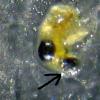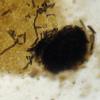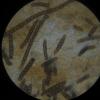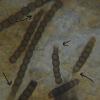
20-12-2025 23:08
Patrice TANCHAUDBonsoir, récolte sur sol sablonneux dans l'arri�

20-12-2025 15:47
Mirek GrycHi.These grew on pine wood that was heavily covere

18-12-2025 21:17
Pol DebaenstThe identification took me to Byssonectria deformi

15-12-2025 07:09
 Danny Newman
Danny Newman
indet. Rutstroemiaceae sp. on unk. fallen leavesMc

19-12-2025 10:10
Patrice TANCHAUDBonjour, récolte réalisée en milieu dunaire, a

18-12-2025 17:23
 Bruno Coué
Bruno Coué
Bonjour,je serais heureux d'avoir votre avis sur c

18-12-2025 18:07
Margot en Geert VullingsThese plumes were found on rotten wood.They strong

17-12-2025 18:35
 Michel Hairaud
Michel Hairaud
Bonjour à tous/Hi to everyone I am passing along
I have no idea
hannie wijers,
15-03-2013 16:40
With regards
Hannie
Chris Yeates,
15-03-2013 18:00

Re : I have no idea
Hello
I think those spores are the condia of a 'hyphomycete"; it would be helpful to see conidiophores; genera such as Dendryphion and some of those similar to Torula can look like this.
I would suggest that these are purely fortuitously on the dung as these fungi are plurivorous on a wide range of dead plant material.
Amitiés
Chris
I think those spores are the condia of a 'hyphomycete"; it would be helpful to see conidiophores; genera such as Dendryphion and some of those similar to Torula can look like this.
I would suggest that these are purely fortuitously on the dung as these fungi are plurivorous on a wide range of dead plant material.
Amitiés
Chris
Mateusz Wilk,
15-03-2013 18:09
Re : I have no idea
Dear Hannie and Chris,
Exactly, this looks more like Torula, Dendryphion would have distinct conidiophores (but can be somewhere on the material).
The question remains what are those "ascomatal" wall remains and those yellow round spore-like bodies...
Regards,
Mateusz
Exactly, this looks more like Torula, Dendryphion would have distinct conidiophores (but can be somewhere on the material).
The question remains what are those "ascomatal" wall remains and those yellow round spore-like bodies...
Regards,
Mateusz
Jacky Launoy,
15-03-2013 18:13
Re : I have no idea
Bonjour,
pour mieux vous aider ce serait bon de voir les asques. Une suggestion serait peut-être Sporormia fimetaria de Not.
Jacky Launoy
pour mieux vous aider ce serait bon de voir les asques. Une suggestion serait peut-être Sporormia fimetaria de Not.
Jacky Launoy
hannie wijers,
15-03-2013 19:25
Re : I have no idea
The yellow round spores, I think they aren from another fruitbody wich came with it. I also saw in the Doveri later this afternoon de Sporormis fimetaria and saw the asci. I could not find asci. I had three pieces under the mic, and couldn't find anyone. Maybe I can look tomorow if I can find a new frb.
Thank you for your answer
Regards
Hannie
Thank you for your answer
Regards
Hannie
Chris Yeates,
15-03-2013 21:40

Re : I have no idea
These conidia are clearly rough-walled which immediately rules out Sporormia; could the yellowish spores not be from a member of the Mucorales? Pilaira or Pilobolus . . . .
best wishes
Chris
best wishes
Chris
Esquivel-Rios Eduardo,
15-03-2013 23:42
Re : I have no idea
I gree looks as Torula graminis
Chris Yeates,
16-03-2013 15:09

Re : I have no idea
= Rutola graminis ;-)
hannie wijers,
16-03-2013 15:39
Re : I have no idea
Chris thanks for the clear explanation why it is not sporomia. Ritola graminis it belongs to the imperfect form or the hyphomyceten? I don't understand it quiet well. And the yellow spores I'll look for it in both species: Pilaria and Pilobolus.
Esquivel thanks for your suggestion. This is something I myself can not imagine.
Regards Hannie
Esquivel thanks for your suggestion. This is something I myself can not imagine.
Regards Hannie





